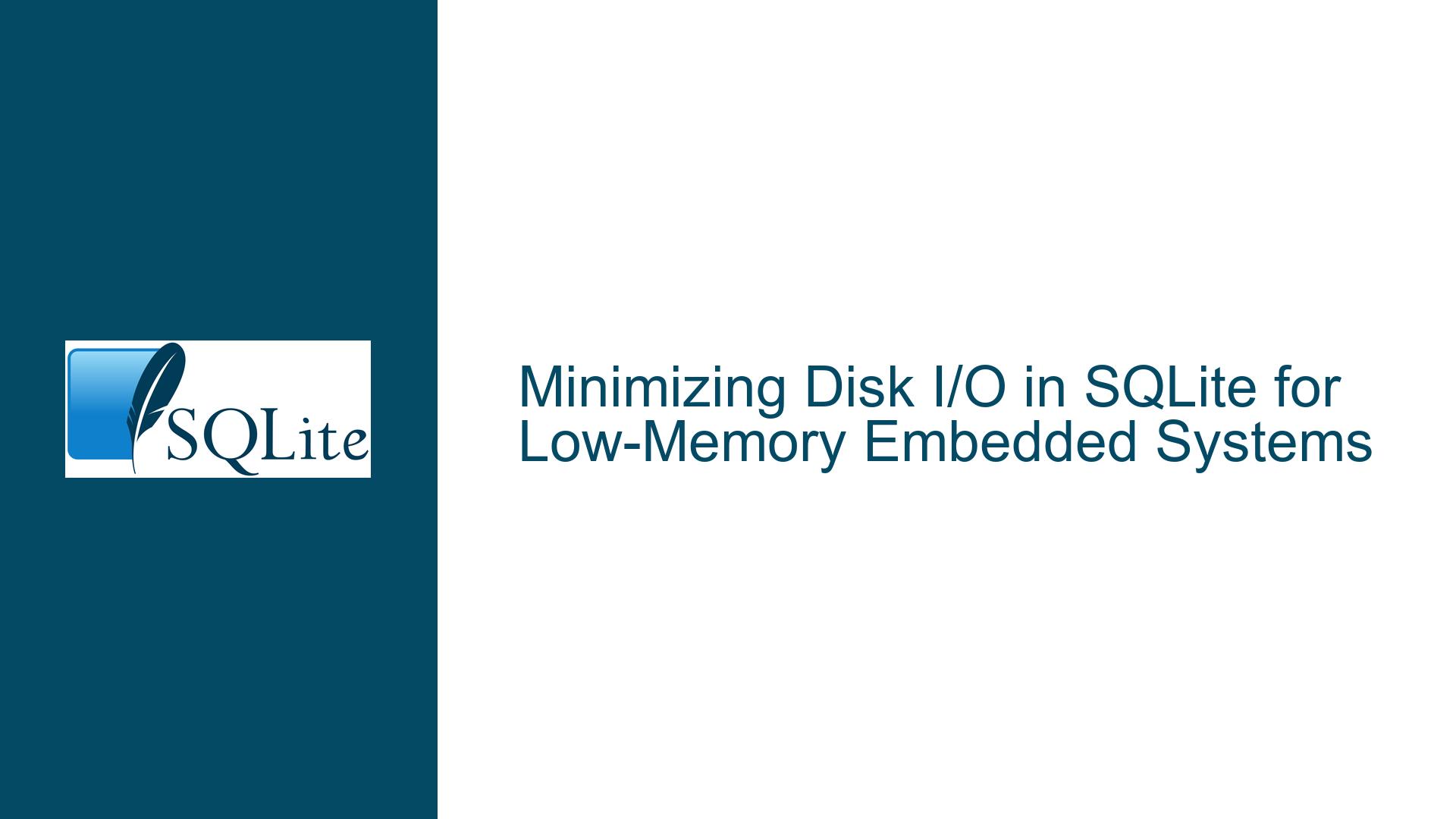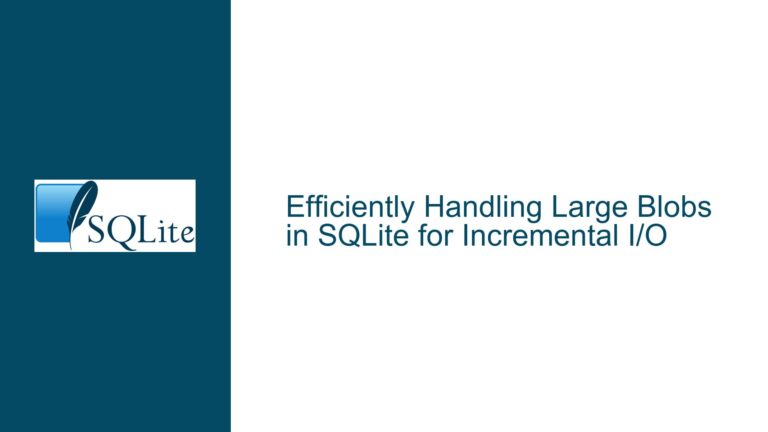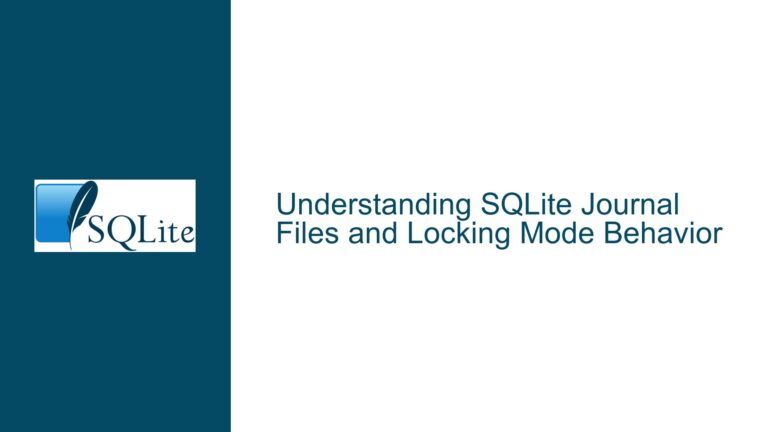Minimizing Disk I/O in SQLite for Low-Memory Embedded Systems
Issue Overview: Frequent Disk Access in Resource-Constrained Environments
The core challenge revolves around optimizing SQLite for embedded systems or devices with limited memory resources while mitigating flash memory wear caused by frequent disk I/O operations. A typical use case involves applications that require rapid database reads (e.g., every 50ms) and periodic writes (e.g., every second), where traditional disk-based caching mechanisms may prove inadequate or harmful to hardware longevity. The primary objectives are to (1) reduce physical disk access frequency, (2) maintain data integrity, and (3) prevent premature flash memory degradation, all while operating within strict memory constraints.
SQLite’s architecture inherently employs a page cache mechanism that buffers frequently accessed database pages in memory. However, this default cache operates as a write-through cache that still requires eventual disk synchronization. When write operations occur at sub-second intervals combined with high-frequency reads, even optimized caching strategies might still generate excessive disk I/O. This becomes critical in flash-based storage systems where write endurance is finite – typically measured in program/erase (P/E) cycles – making aggressive write reduction imperative.
The complexity intensifies when considering transaction boundaries and journaling modes. For instance, SQLite’s default rollback journal mode requires multiple disk writes per transaction (original data to journal, new data to main database, journal deletion), while Write-Ahead Logging (WAL) mode reduces some disk operations but introduces additional wal-file management. Both approaches still involve disk synchronization points that conflict with the requirement for minimal flash wear.
Possible Causes: Architectural Constraints and Configuration Misalignments
1. Default Page Cache Limitations
SQLite’s built-in page cache (controlled by PRAGMA cache_size) manages frequently accessed database pages in memory but does not eliminate disk writes. The cache operates in conjunction with the underlying operating system’s buffer cache, creating a dual-layer caching system. However, on systems with limited RAM, both layers may be undersized, forcing premature cache evictions and subsequent disk reloads. Worse, write operations still flush dirty pages to disk based on transaction commits or cache pressure, making pure in-memory operation impossible with standard configurations.
2. Transaction Granularity and Journaling Overhead
Frequent small transactions (e.g., per-second writes) exacerbate disk I/O through journal file operations. Each transaction in rollback journal mode requires:
- Journal header write
- Original page contents preservation
- Database page updates
- Journal file synchronization
- Journal file deletion
Even with WAL mode, which reduces contention between readers and writers, the WAL file grows until checkpoint operations merge changes back to the main database. Checkpoint triggers (automatic or manual) still incur disk I/O that scales with write frequency.
3. Lack of Explicit Memory-Backed Storage Strategy
When applications naively use disk-based databases without leveraging SQLite’s memory-oriented features, all operations route through the file system layer. This becomes problematic when:
- The OS’s disk cache is disabled or undersized
- File system mounts enforce synchronous writes (
PRAGMA synchronous=FULL) - Hardware lacks battery-backed write buffers
4. Suboptimal Connection Handling
Persistent database connections that alternate between read and write operations may inadvertently trigger repeated cache validation checks against the disk file. New connections typically perform a file header read to verify database state, adding incremental I/O pressure.
Troubleshooting Steps, Solutions & Fixes: Strategic Memory Utilization and I/O Orchestration
1. Implementing Dual Database Strategy with Backup API
Architecture Design
Deploy two interconnected databases:
- Memory Database: Primary operational store handling all read/write operations
- Disk Database: Persistent storage synchronized at controlled intervals
Implementation Steps
a. Initialize Memory Database
Create an in-memory instance using either:
ATTACH DATABASE ':memory:' AS memdb;
or a shared memory database for multi-thread access:
ATTACH 'file:memdb?mode=memory&cache=shared' AS memdb;
b. Load Initial Data
Populate the memory database from disk at startup using sqlite3_backup_init():
sqlite3_backup *pBackup = sqlite3_backup_init(memdb, "main", diskdb, "main");
if(pBackup){
sqlite3_backup_step(pBackup, -1); // Copy entire DB
sqlite3_backup_finish(pBackup);
}
c. Synchronization Protocol
Establish a write-back strategy where memory DB changes propagate to disk at controlled intervals (e.g., every 10 minutes instead of every second):
def periodic_sync():
while True:
time.sleep(600) # 10-minute interval
with sqlite3.connect('file:memdb?mode=memory&cache=shared') as src:
with sqlite3.connect('disk.db') as dst:
src.backup(dst)
Optimization Considerations
- Delta Tracking: Use
PRAGMA schema_versionto detect schema changes before full backups - Incremental Backup: Leverage
sqlite3_backup_step()with page limits to spread I/O over multiple cycles - Transaction Batching: Accumulate writes in memory and flush as single transactions to disk
2. Journal Mode and Synchronization Tuning
WAL Mode Configuration
Enable Write-Ahead Logging for concurrent access and reduced disk writes:
PRAGMA journal_mode=WAL;
Combine with non-volatile RAM for WAL file storage (if available) to prevent fsync() calls.
Synchronous Relaxation
Adjust synchronization guarantees based on power failure resilience:
PRAGMA synchronous=NORMAL; # Balanced durability vs. performance
PRAGMA synchronous=OFF; # Riskier but eliminates fsync()
Checkpoint Control
Manually trigger WAL checkpoints during low-activity periods:
PRAGMA wal_checkpoint(TRUNCATE); # Reset WAL file after checkpoint
3. Memory Database Lifetime Management
Shared Cache Configuration
For multi-threaded applications, use a named memory database with shared cache:
sqlite3_open_v2("file:memdb?mode=memory&cache=shared", &db,
SQLITE_OPEN_READWRITE | SQLITE_OPEN_CREATE | SQLITE_OPEN_URI, NULL);
Persistent Memory Backing
On systems with swap or tmpfs partitions, mount a RAM disk and use it as a transient storage layer:
# Linux tmpfs mount
mount -t tmpfs -o size=256M tmpfs /mnt/sqlite_ram
Then open databases via /mnt/sqlite_ram/app.db, combining memory-like speed with optional persistence.
4. Query and Schema Optimization
Page Size Alignment
Match database page size to flash memory sector size (typically 4KB):
PRAGMA page_size=4096;
Indexing Strategy Audit
Use EXPLAIN QUERY PLAN to eliminate unnecessary full-table scans:
EXPLAIN QUERY PLAN SELECT * FROM sensors WHERE timestamp > ?;
Columnar Storage Consideration
For time-series data, structure tables to cluster frequently accessed columns:
CREATE TABLE readings (
ts INTEGER PRIMARY KEY,
sensor1 REAL, # High-frequency accessed
sensor2 REAL, # Rarely accessed
...,
sensorN REAL
) WITHOUT ROWID;
5. Monitoring and Validation
I/O Profiling
Enable SQLite’s I/O trace using sqlite3_trace_v2() to log all file operations:
sqlite3_trace_v2(db, SQLITE_TRACE_STMT,
(int(*)(unsigned,void*,void*,void*))trace_cb, NULL);
Cache Hit Rate Analysis
Calculate cache efficiency via:
PRAGMA stats;
SELECT * FROM sqlite_stats;
Flash Wear Estimation
Monitor write amplification factor (WAF) using:
# Linux sysfs for MMC devices
cat /sys/block/mmcblk0/mmcblk0rpmb/life_time
6. Alternative Concurrency Models
Reader-Writer Lock Abstraction
Implement application-level locking to batch writes:
class DBManager:
def __init__(self):
self.write_lock = threading.Lock()
def buffered_write(self, data):
with self.write_lock:
# Accumulate data in memory structure
self.buffer.append(data)
if len(self.buffer) >= 1000:
self.flush_to_disk()
def flush_to_disk(self):
with sqlite3.connect(':memory:') as mem:
# Bulk insert buffered records
mem.executemany("INSERT ...", self.buffer)
mem.backup(disk_db)
self.buffer.clear()
Conclusion
By strategically combining SQLite’s memory database capabilities with carefully orchestrated synchronization protocols, developers can achieve order-of-magnitude reductions in disk I/O operations. The optimal solution typically involves a tiered storage architecture where a memory-resident database handles real-time operations while a disk-based counterpart serves as a persistent store synchronized at hardware-friendly intervals. This approach must be augmented with rigorous transaction batching, journal mode optimization, and continuous performance monitoring to balance durability requirements with flash memory longevity constraints.






